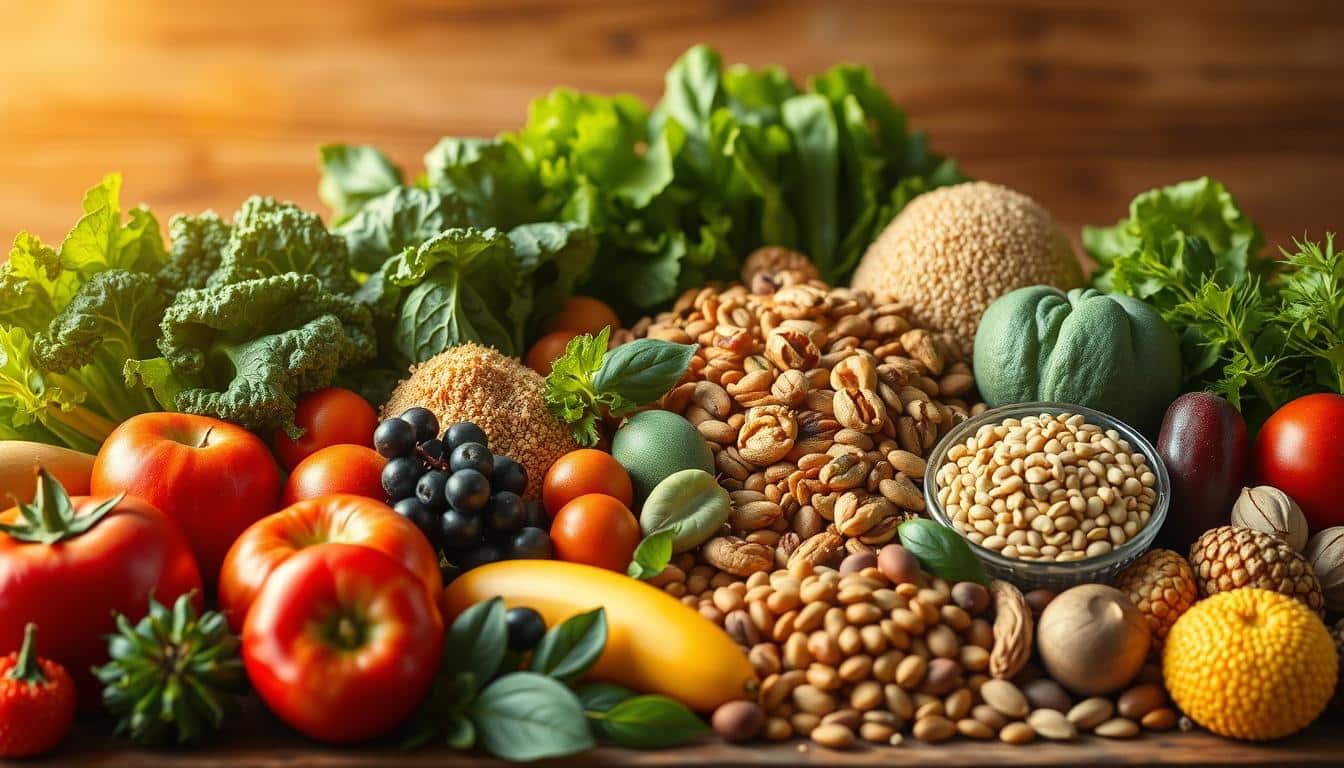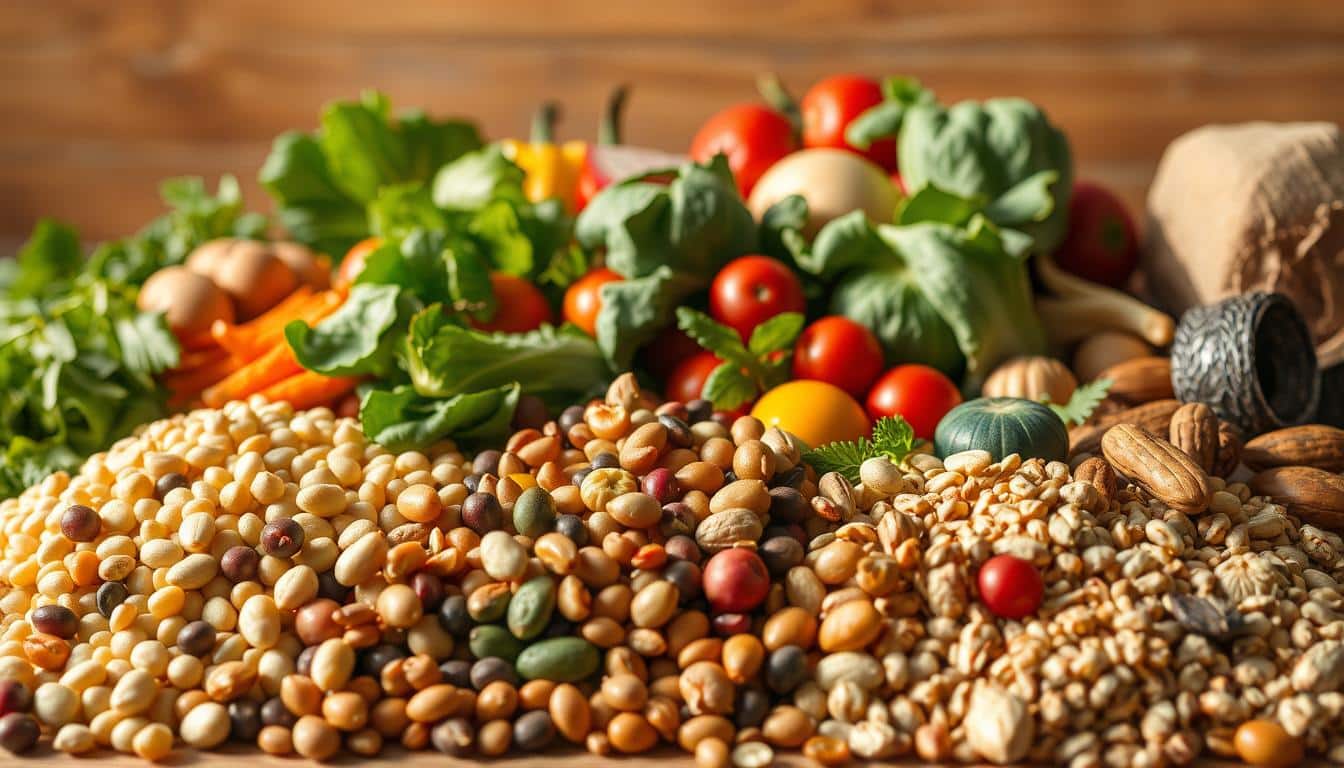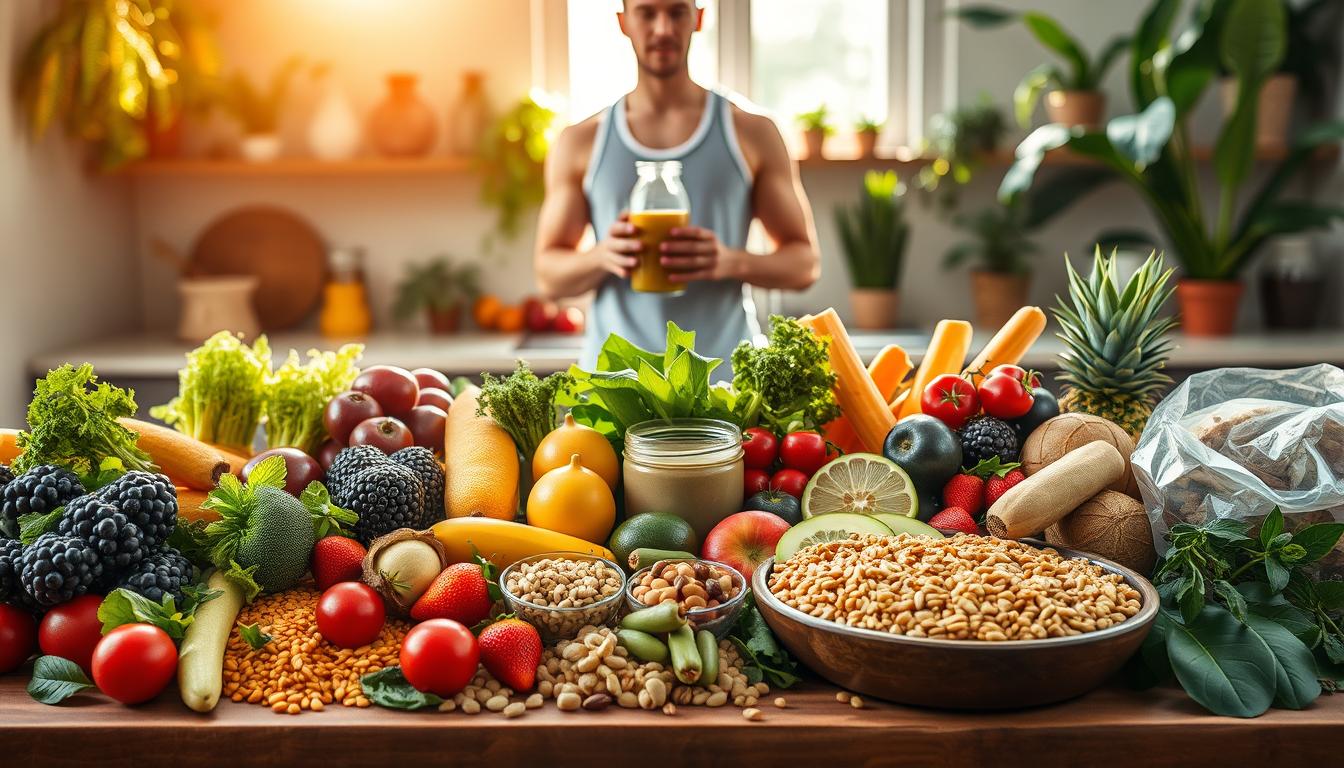What if your best performance doesn’t require steak or chicken? More competitors are discovering how nutrient-packed meatless dishes deliver everything they need. Let’s explore how simple ingredients become powerhouses for muscle growth and recovery.
You’ll find meals packing 14-27 grams of protein per serving using staples like lentils and quinoa. These aren’t bland bowls of greens – think smoky tempeh tacos or peanut butter overnight oats that keep you energized for hours. The secret? Combining complementary ingredients to create complete amino acid profiles.
We’ve gathered insights from athletes who’ve made the switch. One marathoner shares: “My recovery time improved when I focused on whole-food sources like chickpeas and hemp seeds.” No expensive supplements or chalky powders required – just smart combinations of accessible ingredients.
Concerned about taste? These recipes prioritize flavor as much as nutrition. Spiced black bean burgers and sesame-glazed tofu bowls prove that fueling your body can be delicious. Ready to rethink what’s possible with plants?
Introduction
The key to unlocking your athletic potential might be simpler than you think. Your body needs quality fuel to build strength and recover fast—and that starts with understanding protein’s role. Let’s break down why this nutrient matters and how smart food choices keep you performing at your best.

Article overview and purpose
This guide shows how to meet your needs without relying solely on meat. You’ll discover tasty options that deliver 15-25 grams per serving while supporting muscle growth. We focus on science-backed strategies that real athletes use daily.
Why protein matters for athletes
Protein repairs muscle fibers after intense workouts. Without enough, you’ll struggle to gain strength or bounce back quickly. The right protein sources also provide energy for training and help prevent injuries.
Many competitors now prefer non-meat options for better digestion and reduced inflammation. Pairing foods like rice and beans creates complete amino acid profiles—just like animal products. Check how different options stack up:
| Source | Grams Protein | Bonus Benefits |
|---|---|---|
| Lentils (1 cup) | 18 | Iron + Fiber |
| Tempeh (3 oz) | 16 | Probiotics |
| Quinoa (1 cup) | 8 | All 9 Amino Acids |
Consistency matters most. Spread your intake across meals—try adding high-energy breakfast foods to kickstart muscle repair. With proper planning, you’ll hit targets effortlessly while enjoying every bite.
What Defines Plant Based High Protein Meals
Muscle-building dishes don’t need animal products to deliver results. The best options combine everyday ingredients you likely already stock. Think lentils simmered with spices, crispy baked tofu, or nutty quinoa bowls – each delivering 15-20 grams per serving while keeping prep straightforward.

Simple ingredients, clear structure
These dishes follow a no-fuss formula: start with a protein-rich base like beans or tempeh. Add whole grains for sustained energy, then veggies for crunch and nutrients. A drizzle of tahini or sprinkle of seeds boosts both flavor and amino acids.
Combining foods matters. Pair rice with black beans, or whole wheat pita with hummus. These duos create complete proteins that support muscle repair as effectively as meat. No fancy techniques required – just smart pairings from your pantry.
Direct benefits of plant protein
Beyond building strength, these meals work harder for you. The fiber in chickpeas and edamame keeps energy stable during long workouts. Antioxidants in colorful veggies speed recovery, while healthy fats from nuts reduce inflammation.
You’ll notice the difference quickly. Lighter digestion means more energy for training, not fighting post-meal fatigue. Plus, you’re getting nutrients most animal proteins lack – like magnesium from spinach or zinc from pumpkin seeds.
Nutrient-Rich Protein Sources in Vegan Meals
The secret to muscle recovery might be in your pantry. Everyday staples like lentils and soy products deliver the amino acids your body craves after tough workouts. Let’s explore how these ingredients become your new training partners.
Legumes and beans
You’ll find lentils and chickpeas leading the pack. One cup of cooked lentils packs 18 grams of protein – perfect for post-run soups. White beans? They’re not just for chili. Toss them into salads for 17 grams per cup plus a magnesium boost.
These humble ingredients do double duty. The iron in chickpeas helps oxygen reach tired muscles faster. Plus, their fiber keeps you full during long training sessions without digestive drag.
Tofu, tempeh, and soy products
Tofu’s blank canvas absorbs any flavor you throw at it. A 3-ounce serving delivers 19 grams of protein – grill it, bake it, or scramble it. Tempeh adds crunch with 16 grams per serving and gut-friendly probiotics.
Fermented soy products like miso bring extra benefits. They help your body absorb nutrients better, meaning more fuel from every bite. Combine them with veggies for meals that rebuild muscle and keep energy steady.
Quick and Easy Recipe Ideas
Time-crunched athletes need meals that fuel without fuss. These recipes skip complicated steps but keep nutrition front and center. You’ll spend less time prepping and more time recovering – or crushing your next workout.
Fast Tofu Stir-Fry
Grab super-firm tofu (no pressing needed) and frozen veggies. Crumble the tofu into bite-sized pieces – it soaks up sauces faster. Sauté everything in a hot pan for 5-7 minutes. Done.
This dish delivers 19 grams of protein per serving. Swap veggies weekly to keep things fresh. Try adding pineapple chunks or chili flakes for sweet-heat balance.
Simple Chickpea Salad
Mix canned chickpeas with diced cucumber, cherry tomatoes, and lemon-tahini dressing. Crunchy, creamy, and ready in minutes. Each bowl packs 16 grams of muscle-supporting power.
Make it portable by stuffing the salad into whole-grain wraps. Add avocado slices or roasted red peppers for extra flavor layers without slowing prep time.
| Recipe | Prep Time | Protein Per Serving | Key Ingredients |
|---|---|---|---|
| Tofu Stir-Fry | 12 minutes | 19g | Super-firm tofu, mixed vegetables |
| Chickpea Salad | 8 minutes | 16g | Chickpeas, tahini, fresh veggies |
Both recipes adapt to whatever’s in your fridge. The secret? Focus on texture contrasts and bold seasonings. Your taste buds won’t believe how fast these came together.
Creative Bowl and Salad Combinations
Your next training session deserves better than boring meals. Let’s transform simple ingredients into vibrant bowls and salads that keep you energized. These combinations prove nutrition and flavor can coexist – no compromise needed.
Power-Packed Grain Bowls
Quinoa and lentils become muscle-building superstars when combined. One serving delivers 33 grams of complete protein – that’s more than many chicken dishes. Mix roasted veggies, fresh herbs, and a lemon-tahini drizzle for texture variety.
Prep these bases weekly for quick assembly. Monday’s bowl might feature spicy chickpeas, while Thursday’s gets smoky paprika sweet potatoes. You’ll never feel stuck in a food rut.
Smart Salad Upgrades
Black beans and avocado turn greens into recovery tools. The combination provides healthy fats that help absorb nutrients from leafy greens. Add quinoa for extra staying power – you’ll get 16 grams per serving without heavy dressings.
Try massaging kale with lime juice to soften it. Top with charred corn or crispy baked tofu bits. Your taste buds won’t believe it’s fuel-first eating.
| Recipe | Prep Time | Protein (grams) | Key Features |
|---|---|---|---|
| Quinoa Lentil Bowl | 20 mins | 33 | Complete amino acids, 5+ veggies |
| Black Bean Salad | 15 mins | 16 | Healthy fats, fiber boost |
| Sweet Potato Buddha Bowl | 25 mins | 19 | Anti-inflammatory spices |
Global Flavors in Vegan Protein Meals
Your taste buds don’t need a passport to explore muscle-fueling meals. Global spices and cooking methods turn simple ingredients into recovery powerhouses. Let’s dive into two crowd-pleasing options that prove nutrition and adventure go hand-in-hand.
Moroccan Lentil Soup
This hearty dish delivers 21 grams of protein per serving while warming you from the inside out. Cumin and turmeric boost both flavor and digestion. Pair it with whole-grain bread for a complete amino acid profile that supports muscle repair.
Best part? It freezes perfectly. Make a big batch for high-protein slow cooker recipes that simplify busy weeks. The lentils’ iron content helps oxygenate tired muscles faster – crucial after endurance training.
Asian-Inspired Tofu Creations
Kung Pao tofu packs 18 grams of protein per serving with a spicy-sweet kick. Tamari-based sauce adds depth without overwhelming the palate. Ginger and garlic bring anti-inflammatory benefits, perfect for recovery days.
For creamier options, try coconut-curry tofu. One bowl provides 14 grams of protein alongside healthy fats from coconut milk. Serve over jasmine rice to balance heat with subtle sweetness.
| Dish | Protein (grams) | Key Spices | Prep Time |
|---|---|---|---|
| Moroccan Lentil Soup | 21 | Cumin, Turmeric | 40 mins |
| Kung Pao Tofu | 18 | Ginger, Chili | 25 mins |
| Coconut Curry Tofu | 14 | Lemongrass, Coriander | 30 mins |
These globally-inspired meals keep your nutrition plan exciting. Rotate them weekly to prevent flavor fatigue while hitting your protein targets effortlessly.
Athletes and plant based high protein meals
What fuels your toughest workouts and fastest recovery? Smart food choices make all the difference. Discover how nutrient-dense options support peak performance without weighing you down.
Why Your Body Thrives
You’ll bounce back faster thanks to natural anti-inflammatory compounds in legumes and seeds. These reduce muscle soreness after intense sessions. Combine different sources like quinoa and black beans throughout the day for complete amino acid profiles.
Meals delivering 20-37 grams per serving match animal-based options. The table below shows how top choices stack up:
| Meal | Grams Protein | Recovery Boosters |
|---|---|---|
| Lentil & Walnut Loaf | 24 | Omega-3s + Iron |
| Edamame Rice Bowl | 22 | Fiber + Vitamin K |
| Chickpea Curry | 19 | Turmeric + Ginger |
Fueling Muscle Growth
Building strength starts in the kitchen. Foods rich in leucine – like tempeh and peas – kickstart muscle repair. Pair them with complex carbs from sweet potatoes or oats for sustained energy.
Check these powerful combinations:
| Protein Source | Grams Per Serving | Perfect Pairing |
|---|---|---|
| Hemp Seeds | 10 | Overnight Oats |
| Seitan | 25 | Stir-Fried Veggies |
| Spirulina | 4 | Post-Workout Smoothies |
You don’t need animal products to hit your targets. With strategic pairings and portion sizes, every meal becomes an opportunity to rebuild stronger.
Tips for Meal Planning and Prep
Your busiest training weeks need a game plan. Smart prep turns weekend effort into weekday wins. Let’s streamline your kitchen time so you fuel right without the daily scramble.
Simple Steps for Batch Cooking
Start with protein-rich bases that work across meals. Cook 2 cups of lentils Sunday night – they’ll become tacos, soups, and salads. Roast three trays of seasoned tofu cubes for stir-fries or grain bowls.
Here’s how to maximize efficiency:
| Prep Component | Time Saved | Protein Per Serving | Usage Examples |
|---|---|---|---|
| Quinoa (4 cups cooked) | 25 minutes | 8 grams | Breakfast bowls, stuffed peppers |
| Lentil Soup (6 portions) | 40 minutes | 21 grams | Lunch thermos, dinner base |
| Marinated Tempeh | 15 minutes | 16 grams | Sandwiches, salad toppers |
Store components separately for mix-and-match freedom. Glass containers keep grains fresh 5 days. Freeze soups in portioned jars – thaw overnight for ready-to-go meals.
Rotate three core recipes weekly to avoid boredom. Monday’s chili becomes Wednesday’s baked potato topping. Friday’s stir-fry veggies jazz up weekend omelets. You’ll hit 20+ grams per serving without repeating flavors.
How to Boost Flavor and Texture
Great meals start with bold flavors and satisfying textures – no fancy skills required. Here’s how to elevate your plate using ingredients already in your kitchen.
Using Sauces and Spices
You’ll transform simple ingredients with sauces that pull double duty. Peanut butter blended with lime juice creates a creamy drizzle adding 5 grams of protein per serving. Almond butter mixed with tamari becomes a savory dip for crispy tofu.
Spice blends work magic too. Try smoked paprika on roasted chickpeas or turmeric-garlic mix for tempeh. These combos add depth without extra calories. Check how sauces boost nutrition:
| Sauce | Protein Per Serving | Best Uses |
|---|---|---|
| Peanut Sauce | 7g | Stir-fries, grain bowls |
| Almond Butter Dressing | 5g | Salads, roasted veggies |
| Tahini-Lemon | 3g | Drizzles, marinades |
Enhancing Natural Taste With Fresh Ingredients
Fresh garlic and ginger brighten flavor profiles instantly. Toss minced garlic into sautéed greens or grate ginger over steamed edamame. Citrus zest adds spark – try orange peel in chili or lime in curry.
Balance texture for restaurant-quality results. Pair crunchy sesame seeds with silky hummus, or crispy baked tofu with velvety squash puree. These contrasts keep every bite exciting while supporting your nutrition goals.
Conclusion
Your plate holds more power than you realize. Combining smart ingredients like lentils and quinoa creates complete nutritional profiles that rival traditional options. Every dish becomes an opportunity to fuel stronger performances and faster recovery.
Don’t settle for bland routines. Those smoky black bean tacos or zesty chickpea salads prove that vibrant flavors and muscle support go hand-in-hand. With 15-30 grams per serving, these recipes meet athletic demands without complicated prep.
Keep it simple. Batch-cook grains like rice for quick bowl assemblies, or toss roasted veggies with canned beans for last-minute dinner wins. The key? Focus on texture contrasts and globally-inspired spices that make every bite exciting.
Ready to transform how you eat? Start with one swap this week – maybe tempeh stir-fry instead of chicken. Your body will thank you with better energy levels and quicker bounce-back after tough sessions. Game-changing nutrition is just a grocery list away.


